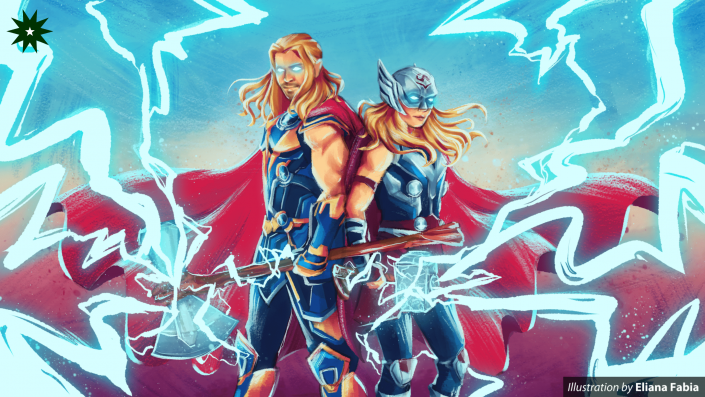Following the success of Thor: Ragnarok comes Chris Hemsworth’s Thor Odinson in the swashbuckling Thor: Love and Thunder. Audiences were more than ecstatic to once again see the god of thunder wield his mighty Stormbreaker on the big screen, along with the much-awaited reunion of Thor and Natalie Portman’s Jane Foster. But amid all the traction and excitement, did the film really deliver?

Only time
The plot of the fourth installment takes place after the events of Avengers: Endgame, with Thor cruising around space with the Guardians of the Galaxy. However, his himbo-tourist era took over him, proclaiming that his “superhero-ing days are over” and saying he prefers to be alone at peace. With all the deaths and trauma he had to process, Thor’s struggle to find inner solitude and existential crisis was most understandable.
From being a rebellious Prince of Asgard in the first two Thor films to dealing with depression in Avengers: Endgame, Hemsworth’s character has come a long way. Among all the Avengers, his character has experienced the most complexities and adversities, leading to his persona’s remarkable development. His unfiltered journey to solace and acceptance is an excellent touch by the screenwriters, as this makes the god of thunder more relatable and human. Indeed, Thor’s “strongest Avenger” image isn’t only applicable to his physical strength but to his mental and emotional resilience as well.
But his beautiful character arc could not stop the franchise from encountering a dry spell. The creators seem to be at a creative dead end for what to do with his character. Although Thor’s jokes and punchlines—his coping mechanisms to mask life’s agonies—were witty enough to make the audience laugh, his story may soon need a break from the box office.
The wait is over
Portman’s comeback to Marvel as Lady Thor is undoubtedly one of the film’s highlights. Sadly, her transition to the role was underwhelming. Everyone was expecting a dramatic, worth-gasping epiphany and action scenes under her belt that would have audiences on the edge of their seats. Audiences had expectations much like when Captain America said “Avengers, assemble” or when the three Spider-Men met each other in Spider-Man: No Way Home. But all moviegoers got was a cringy three-part speech.
With a lack of character development for Jane, many asked why she was even gifted the mantle of the Mighty Thor. The last time the new heroine was seen was two films ago in Thor: The Dark World. The sudden appearance of Jane came as a surprise, with many believing that she had not done much to deserve it. Ultimately, her character development felt forced and unaligned with the Marvel Cinematic Universe (MCU), as if the filmmakers only used her for fan service. What the audience got was a brief—thus lacking—montage explaining her newfound role.
Tessa Thompson’s King Valkyrie also returned for the fourth movie. From combating forces of evil as a shield-maiden to girlbossing her way as the supreme leader of New Asgard, Valkyrie has one of the most major character developments in the film. However, one aspect of the storyline director Taika Waititi failed to touch upon is Valkyrie’s sexual identity—despite it being the initial plan for her character, as mentioned by Marvel Studios head Kevin Feige in Comic-Con 2019. Still, Thor: Love and Thunder didn’t explore much of Valkyrie’s queerness.
But the real star was Christian Bale’s Gorr the God Butcher. Bale gave Gorr layers upon layers of character and emotion, wholeheartedly playing the heartbroken father and giving the godslayer a genuine core. While audiences were hoping for Thor to defeat him, they also ended up seeing him as a “good” villain and agreed with his sentiments that many of the gods do not deserve their worshippers’ reverence. But the character also became just one of the villains that the MCU tried to make audiences empathize with. In the end, Gorr became nothing too unique in that sense.
Color amid darkness
Marvel fans first caught a glimpse of Waititi’s colorful direction in Thor: Ragnarok, which contrasted the preceding dark and dooming films. While the infamous Kiwi director is known for injecting humorous quips into most scenes, he proved himself to be multifaceted through Love and Thunder, serving audiences with both happiness and tragedy throughout the film. The visually pleasing film was a delight for audiences to see, giving them the color they needed after the doom-and-gloom of preceding MCU movies. However, there was a certain lack of Waititi-ness in the film’s direction, with Thor’s himbo-tourist era seeming more forced than natural.
Unfortunately, the movie left audiences scratching their heads, serving as another questionable film in the latest phase of the MCU. It seems that MCU’s Phase Four movies have only left a trail of questions, the most obvious one being: “Where is this whole phase actually going?”
Despite the uncertainties, there is one thing we know for sure—this is not the last audiences will see of the god of thunder.
